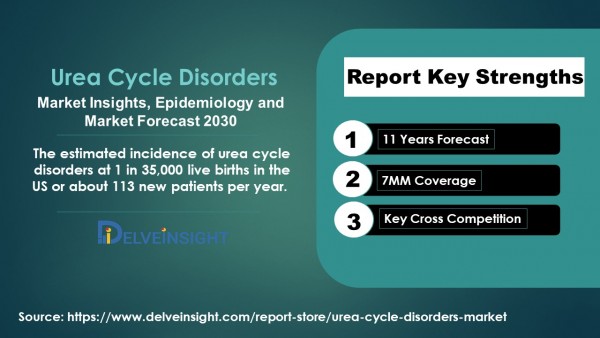A Urea Cycle Disorder (UCD) is a genetic disorder that results in a deficiency of some major enzymes in the urea cycle. These enzymes are responsible for removing ammonia from the blood stream. The urea cycle involves a series of biochemical steps in which nitrogen, a waste product of protein metabolism, is changed to a compound called urea and removed from the blood. Normally, the urea is removed from the body through the urine. In urea cycle disorders, nitrogen builds up in the blood in the form of ammonia, a highly toxic substance, resulting in hyperammonemia (elevated blood ammonia). Ammonia then reaches the brain through the blood, where it can cause irreversible brain damage, coma, and/or death. The onset and severity of urea cycle disorders is highly variable. The severity correlates with the amount of urea cycle enzyme function.
DelveInsight's "Urea Cycle Disorders Market Report 2030" report delivers an in-depth understanding of the Urea Cycle Disorders, historical and forecasted epidemiology as well as the Urea Cycle Disorders market trends in the United States, EU5 (Germany, Spain, Italy, France, and United Kingdom) and Japan.

A few of the enzymes which are involved in the Urea Cycle Disorder, collectively known as inborn errors of urea synthesis, or urea cycle enzyme defects; each is referred to by the initials of the missing enzyme: CPS1 (Carbamoyl Phosphate Synthetase), NAGS (N-Acetylglutamate Synthetase), OTC Deficiency (Ornithine Transcarbamylase), AS (Argininosuccinic Acid Synthetase (Citrullinemia)), ASL (Argininosuccinate Lyase (Argininosuccinic Aciduria)), and AG (Arginase).
In children with severe UCD, the symptoms will develop within the first 24 hours of life. Symptoms in children with mild or moderate UCD, who do not show symptoms until early childhood, may include: Vomiting, nausea, Mental confusion or hyperactive behaviour, Tired often and/or hard to awaken, Coma, etc.
View report: https://www.delveinsight.com/report-store/urea-cycle-disorders-market
Treatment is a lifelong process that doesn't cure the condition, but it can effectively manage the symptoms. The child's treatment probably will involve:
•Low protein, high-calorie diet
•Medications
•Amino acid supplements
•Liver transplantation
Geography Covered
- The United States
- EU5 (Germany, France, Italy, Spain, and the United Kingdom)
- Japan
Study Period: 2017-2030
Urea Cycle Disorders Disease Overview
The DelveInsight Urea Cycle Disorders market report gives a thorough understanding of the Urea Cycle Disorders by including details such as disease definition, symptoms, causes, pathophysiology, diagnosis and treatment.
Urea Cycle Disorders Epidemiology Key Findings:
"The estimated incidence of urea cycle disorders at 1 in 35,000 live births in the US or about 113 new patients per year."
Key pharma players:
1. Ultragenyx Pharmaceutical
2. Acer Therapeutics
3. Aeglea BioTherapeutics
4. Promethera Biosciences
5. Kaleido Biosciences
Request a sample copy of the report: https://www.delveinsight.com/sample-request/urea-cycle-disorders-market
Urea Cycle Disorders Market Outlook
The Urea Cycle Disorders market outlook of the report helps to build the detailed comprehension of the historic, current, and forecasted Urea Cycle Disorders market trends by analyzing the impact of current therapies on the market, unmet needs, drivers and barriers and demand of better technology.
Recent advances in the treatment of inborn errors of urea synthesis have significantly decreased mortality. The treatment of urea cycle disorders consists of dietary management to limit ammonia production, in conjunction with medications and/or supplements which provide alternative pathways for the removal of ammonia from the bloodstream. The aim is to correct biochemical abnormalities and ensure adequate nutritional intake. Treatment involves compounds that increase the removal of nitrogen waste. These compounds convert nitrogen into products other than urea, which are then excreted; hence, the load on the urea cycle is reduced. The first compounds to be used were sodium benzoate and arginine. Later, phenylacetate was used, which has now been replaced by phenylbutyrate.
Hemodialysis is very effective at reducing plasma ammonia and should immediately be initiated if elevated hyperammonemia is observed. Ammonia scavenger medications such as Ammonul IV are also useful. Ammonul IV acts by removing glycine and glutamate from plasma thereby their reducing contribution to ammonia formation.
According to DelveInsight, Urea Cycle Disorders market in 7MM is expected to change in the study period 2017-2030.
Scope of the Report
- The report covers the descriptive overview of Urea Cycle Disorders, explaining its causes, signs and symptoms, pathophysiology, diagnosis and currently available therapies
- Comprehensive insight has been provided into the Urea Cycle Disorders epidemiology and treatment
- An all-inclusive account of both the current and emerging therapies for Urea Cycle Disorders are provided
- A detailed review of Urea Cycle Disorders market; historical and forecasted is included in the report, covering drug outreach
- The report provides an edge while developing business strategies, by understanding trends shaping and driving the global Urea Cycle Disorders market
Download sample pages of the report: https://www.delveinsight.com/sample-request/urea-cycle-disorders-market
Table of contents
1 Key Insight
2 Executive Summary of Urea Cycle Disorders
3 Urea Cycle Disorders Market Overview at a Glance
4 Disease Background and Overview: Urea Cycle Disorders
5 Case Reports
6 Urea Cycle Disorders Epidemiology and Patient Population
7 United States Epidemiology
8 EU5 Epidemiology
9 Japan Epidemiology
10 Current Urea Cycle Disorders Treatment and Medical Practices
11 Unmet needs
12 Urea Cycle Disorders Marketed Drugs
13 Urea Cycle Disorders Emerging Drugs
14 Urea Cycle Disorders 7MM Market Analysis
15 United States
16 EU-5 countries: Market Outlook
17 Japan Market Outlook
18 Urea Cycle Disorders Market Drivers
19 Urea Cycle Disorders Market Barriers
20 SWOT Analysis
21 Reimbursement and market access
22 Appendix
23 DelveInsight Capabilities
24 Disclaimer
25 About DelveInsight
Similar Reports
- Urea Cycle Disorders - Pipeline Insights, 2020
- Urea Cycle Disorders - Epidemiology Forecast to 2030
About DelveInsight
DelveInsight is a leading Business Consultant, and Market Research Firm focused exclusively on life sciences. It supports pharma companies by providing end to end comprehensive solutions to improve their performance.
Contact us:
Shruti Thakur
info@delveinsight.com
+919650213330
Media Contact
Company Name: DelveInsight Business Research LLP
Contact Person: Kritika Rehani
Email:Send Email
Phone: 9193216187
Address:304 S. Jones Blvd #2432
City: Las Vegas
State: Nevada
Country: United States
Website: https://www.delveinsight.com/

